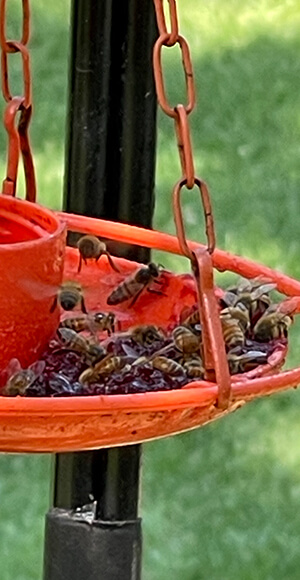
Purple “honey”
Dear Mr. Makovec,
Approximately five years ago, I posted on a honey bee blog that perhaps the purple honey some beekeepers are surprised to find in their supers is due to bees taking grape jelly from oriole bird feeders (I’ll provide a picture of my jelly feeder covered in honey bees). Expectedly, I received no feedback. Over the years I’ve read a lot of speculation regarding the source of purple honey, but resisted reposting the same suggestion.
It was observed that a purple honey tested had very little pollen (the conclusion was that it had been highly filtered), but if jelly is the culprit, there would be limited pollen. A purple honey tested was high in fructose — check. It tastes like grape jam and smells like grape soda — check. There were a few more attributes that, to me, pointed to jelly. So I ventured, almost five years later, to again offer up my humble suggestion. This time I offered the photo of honey bees voraciously stealing my oriole food. And that is where the story ended. The photo I emailed was not uploaded as promised. Further gentle nudges for at least an opinion were denied posting. Perhaps the blogger doesn’t want to give anybody the terrible idea of feeding jelly to their bees. However, I do think this possible answer to the question of purple honey is worthy of consideration. Oddly, bees are not a constant at the feeders. Now that I really want to get to the bottom of this, I have to pay closer attention to exactly when they show up.
In conclusion: Considering bees make honey out of honeydew, why not grape jelly? There are plenty of orioles (and I’m sure people who want to attract them) in the areas where purple honey is found. When conditions are right, when flowers are scarce, or it’s just really hot and jelly is easy pickings, or just because grape jelly is a delightful sweet, bees take my grape jelly home and make honey out of it. Perhaps conditions elsewhere result in a few pounds of purple honey now and then. It’s also possible grapes with dark pulp are growing nearby and the bees are feeding on the ripe fruit. Bees often feed on ripe fruit when necessary, so this is a consideration.
Attached is a closeup cropped from a larger photo taken on Long Island at 1:12, August 2, 2023. It was the first time I thought to document the phenomenon. Some have yellow jackets mixed in. When too many yellow jackets show up, I pull the feeders. Other times it’s just the birds and the bees.
P.S. There’s generally a jelly jar on the top of this particular feeder that feeds jelly to the tray, but the jar was almost empty, so I took it off to let the bees feed out of the center.
Ruth Makofske
Long Island, New York
Eugene responds:
Thanks, Ruth. That is certainly interesting, and I agree with your conclusions. People often think of yellow jackets robbing feeders (especially sugar water feeders for hummingbirds), but honey bees commonly do this in times of dearth if they have access. They also have been known to suck juices from damaged blueberries and other fruit — often torn into first by yellow jackets.


